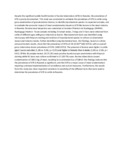| dc.description.abstract | Despite the significant public health burden of bovine tuberculosis (bTB) in Rwanda, the prevalence of bTB is poorly documented. This study was conducted to estimate the prevalence of bTB in cattle using gross examination of granulomatous lesions, to identify mycobacteria species in suspected samples, and to evaluate the economic impact of meat condemnation based on bTB-like lesions in the meat industry in Rwanda. Routine meat inspection was conducted at Societe d'Abattoir de Nyabugogo (SABAN)-Nyabugogo Abattoir. Tissue samples including 31 lymph nodes, 3 lungs and 2 livers were obtained from cattle of different ages with gross tuberculous lesions. Mycobacterium bovis was identified using microscopy with Kinyoun staining and isolation of mycobacterial species in culture on Löwenstein-Jensen and Colestos media, further identified using biochemical tests. Our findings, based on culture and postmortem results, show that the prevalence of bTB is 0.5% (0.587*148/16753), with an overall gross tuberculous lesion prevalence of 0.9% (148/16753). The presence of lesions were higher in cattle aged 2 years and older (1.6% vs. 0.6%, p < 0.05) and higher in females than in males (1.4% vs. 0.6%, p < 0.05). Of the 36 samples tested, 26 (72.2%) were positive by microscopic examination with Kinyoun staining while M. bovis was culture-confirmed in 21 (58.7%) cases. Bovine tuberculosis caused condemnation of 1683.5 kg of meat, resulting in an estimated loss of $4810. Our findings indicate that the prevalence of bTB in Rwanda is significant, and that bTB is a major cause of meat condemnation requiring continued implementation of surveillance and control measures. Furthermore, the results from this study also show important variations in sensitivity of the different tests that were used to determine the prevalence of bTB in cattle in Rwanda. | en_US |

